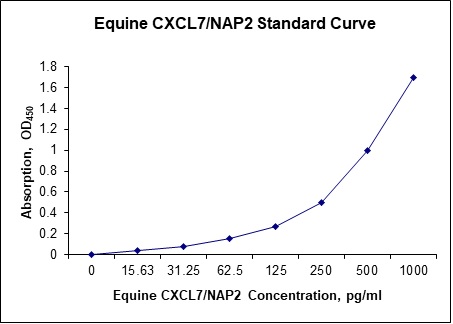Nori Equine CXCL7 ELISA Kit
$461.00 – $832.00
DataSheet CoA SDS
This ELISA kit is for quantification of CXCL7/NAP2 in horse. This is a quick ELISA assay that reduces time to 50% compared to the conventional method, and the entire assay only takes 3 hours. This assay employs the quantitative sandwich enzyme immunoassay technique and uses biotin-streptavidin chemistry to improve the performance of the assays. An antibody specific for CXCL7 has been pre-coated onto a microplate. Standards and samples are pipetted into the wells and any CXCL7 present is bound by the immobilized antibody. After washing away any unbound substances, a detection antibody specific for CXCL7 is added to the wells. Following wash to remove any unbound antibody reagent, a detection reagent is added. After intensive wash a substrate solution is added to the wells and color develops in proportion to the amount of CXCL7 bound in the initial step. The color development is stopped, and the intensity of the color is measured.
Alternative names for CXCL7: Chemokine (C-X-C motif) ligand 7, neutrophil-activating peptide 2 (NAP2)
This product is for laboratory research use only not for diagnostic and therapeutic purposes or any other purposes.
- Description
- How Elisa Works
- Product Citation (0)
- Reviews (0)
Description
Nori Equine CXCL7 ELISA Kit Summary
Alternative names for CXCL7: Chemokine (C-X-C motif) ligand 7, neutrophil-activating peptide 2 (NAP2)
Alternative name for equine: Horse
| Assay Type | Solid Phase Sandwich ELISA |
| Format | 96-well Microplate or 96-Well Strip Microplate |
| Method of Detection | Colorimetric |
| Number of Targets Detected | 1 |
| Target Antigen Accession Number | na |
| Assay Length | 3 hours |
| Quantitative/Semiquantitative | Quantitative |
| Sample Type | Plasma, Serum, Cell Culture, Urine, Cell/Tissue Lysates, Synovial Fluid, BAL, |
| Recommended Sample Dilution (Plasma/Serum) | No dilution for sample <ULOQ; sufficient dilution for samples >ULOQ |
| Sensitivity | 3 pg/mL |
| Detection Range | 15.6-1000 pg/mL |
| Specificity | Natural and recombinant equine CXCL7 |
| Cross-Reactivity | < 0.5% cross-reactivity observed with available related molecules, < 50% cross-species reactivity observed with species tested. |
| Interference | No significant interference observed with available related molecules |
| Storage/Stability | 4 ºC for up to 6 months |
| Usage | For Laboratory Research Use Only. Not for diagnostic or therapeutic use. |
| Additional Notes | The kit allows for use in multiple experiments. |
Standard Curve
Kit Components
1. Pre-coated 96-well Microplate
2. Biotinylated Detection Antibody
3. Streptavidin-HRP Conjugate
4. Lyophilized Standards
5. TMB One-Step Substrate
6. Stop Solution
7. 20 x PBS
8. Assay Buffer
Other Materials Required but not Provided:
1. Microplate Reader capable of measuring absorption at 450 nm
2. Log-log graph paper or computer and software for ELISA data analysis
3. Precision pipettes (1-1000 µl)
4. Multi-channel pipettes (300 µl)
5. Distilled or deionized water
Protocol Outline
1. Prepare all reagents, samples and standards as instructed in the datasheet.
2. Add 100 µl of Standard or samples to each well and incubate 1 h at RT.
3. Add 100 µl of Working Detection Antibody to each well and incubate 1 h at RT.
4. Add 100 µl of Working Streptavidin-HRP to each well and incubate 20 min at RT.
5. Add 100 µl of Substrate to each well and incubate 5-30 min at RT.
6. Add 50 µl of Stop Solution to each well and read at 450 nm immediately.
Background:
Chemokine (C-X-C motif) ligand 7 (CXCL7) also known as neutrophil-activating peptide 2 (NAP2)[1] is a small cytokine belonging to the CXC chemokine family. It is an isoform of Beta-Thromboglobulin or Pro-Platelet basic protein (PPBP).[2] CXCL7 is released in large amounts from platelets following their activation.[3] It stimulates various processes including mitogenesis, synthesis of extracellular matrix, glucose metabolism and synthesis of plasminogen activator.[4] Monocytes secrete CXCL7 to promote breast cancer progression.[5] Along with CCL24, CXCL7 levels increased in the cerebrospinal fluid of patients with neurosyphilis.[6] This growth factor is a potent chemoattractant and activator of neutrophils. It has been shown to stimulate various cellular processes including DNA synthesis, mitosis, glycolysis, intracellular cAMP accumulation, prostaglandin E2 secretion, and synthesis of hyaluronic acid and sulfated glycosaminoglycan. It also stimulates the formation and secretion of plasminogen activator by synovial cells. The protein also is an antimicrobial protein with bactericidal and antifungal activity.
References
- Walz A, Baggiolini M (1990). “Generation of the neutrophil-activating peptide NAP-2 from platelet basic protein or connective tissue-activating peptide III through monocyte proteases”. J. Exp. Med. 171 (2): 449–54.
- Majumdar S, Gonder D, Koutsis B, Poncz M (1991). “Characterization of the human beta-thromboglobulin gene. Comparison with the gene for platelet factor 4”. J Biol Chem. 266 (9): 5785–9.
- Castor C, Miller J, Walz D (1983). “Structural and biological characteristics of connective tissue activating peptide (CTAP-III), a major human platelet-derived growth factor”. Proc Natl Acad Sci USA. 80 (3): 765–9.
- Castor C, Furlong A, Carter-Su C (1985). “Connective tissue activation: stimulation of glucose transport by connective tissue activating peptide III”. Biochemistry. 24 (7): 1762–7.
- Wang YH et al. (2021) Cell Death Dis 12 (12), 1090.
- Li XX et al. (2020) J Clin Lab Anal 34 (9), e23366.
Be the first to review “Nori Equine CXCL7 ELISA Kit”
You must be logged in to post a review.




























Reviews
There are no reviews yet.